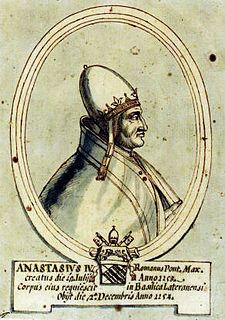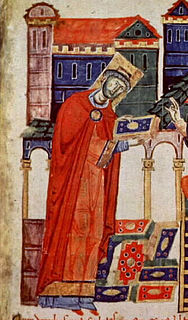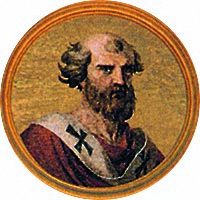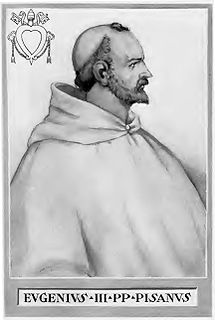Related Research Articles
Pope Celestine II, born Guido di Castello, was head of the Catholic Church and ruler of the Papal States from 26 September 1143 to his death in 1144.
Pope Eugene III, born Bernardo Pignatelli, or possibly Paganelli, called Bernardo da Pisa, was head of the Catholic Church and ruler of the Papal States from 15 February 1145 to his death in 1153. He was the first Cistercian to become pope. In response to the fall of Edessa to the Muslims in 1144, Eugene proclaimed the Second Crusade. The crusade failed to recapture Edessa, which was the first of many failures by the Christians in the crusades to recapture lands won in the First Crusade. He was beatified in 1872 by Pope Pius IX.
Uberto Lanfranchi was the Cardinal-deacon of Santa Maria in Via Lata, then the Cardinal-priest of San Clemente, and finally the Archbishop of Pisa.
Boso was an Italian prelate and Cardinal of the Roman Catholic church.
Jordan was a Carthusian monk, created Cardinal Deacon by Pope Lucius II in December 1144 and then Cardinal Priest of Santa Susanna by Eugene III on 21 December 1145. He is often referred to as a member of the Roman family of the Orsini, but more recent research concludes that he was probably a Frenchman. He served as Camerlengo of the Holy Roman Church under Eugene III and subscribed the papal bulls between 9 January 1145 and 11 June 1154.
Pandulf of Pisa was a twelfth-century Italian cardinal, and biographer of several contemporary popes. He was a native of Rome. He was a nephew of Cardinal Hugo of Alatri. Under Pope Paschal II, and probably with the patronage of his uncle, Pandulf held the post of ostiarius at the papal court. It is deduced from his detailed description of the election of Pope Gelasius II on 24 January 1118 that he was present. On his coronation day, 10 March 1118, Pope Gelasius II elevated him to the rank of Lector and Exorcist. Pope Calixtus II ordained him a subdeacon.

The 1154 papal election followed the death of Pope Anastasius IV and resulted in the election of Pope Adrian IV, the only Englishman to become pope.
Gerard de Namur was a cardinal born in Namur in the modern-day Belgium. In older historiography he is wrongly identified as Gerardo Caccianemici, nephew of Pope Lucius II.
Guido de Summa was an Italian Cardinal.
Hugo was a French Cistercian and Cardinal.

The 1153 papal election followed the death of Pope Eugene III and resulted in the election of Pope Anastasius IV.

In the category of the members of the College of Cardinals in the central Middle Ages, an external cardinal was a Cardinal of the Holy Roman Church who did not reside in the Roman Curia, because of simultaneously being a bishop of the episcopal see other than suburbicarian, or abbot of an abbey situated outside Rome. In the wider sense, it may also concern cardinals who were appointed to the external episcopal sees and resigned their memberships in the College of Cardinals with this appointment. As well, it can concern cardinals who were generally curial cardinals, but for some time exercised the posts of administrators or prelates of the external churches.

The 1143 papal election followed the death of Pope Innocent II and resulted in the election of Pope Celestine II.

The 1144 papal election followed the death of Pope Celestine II and resulted in the election of Pope Lucius II.

The 1145 papal election followed the death of Pope Lucius II and resulted in the election of Pope Eugene III, the first pope of the Order of Cistercians.
Pope Eugene III (1145–1153) created sixteen cardinals in nine consistories:
Pope Lucius II (1144–1145) created eleven cardinals in two consistories.
Pope Celestine II (1143–1144) created nine cardinals in one consistory:
Saxo de Anagnia was a Roman Catholic Cardinal, and Cardinal-priest of the titulus of S. Stefano al Monte Celio in Rome. He was a native of Anagni, and a member of the family of the Conti di Anagni. Dumas points out that there is no positive evidence of the family connection.
References
- ↑ The year of death is given by Pöhlder Annales, the day appears in the necrology of Montecassino, cf. Brixius, Die Mitglieder des Kardinalkollegiums von 1130-1181, p. 95. Some later accounts, cited by Salvador Miranda, indicate that he died in 1153.
- ↑ About the date of his promotion to the cardinalate see Wilhelm Bernhardi: Konrad III., Bd. 1, Leipzig 1883, p. 6 note 9, according to which his successor as abbot of Gorze is attested in 1133.
- ↑ Bachmann, J. "Die päpstliche Legaten in Deutschland und Skandinavien (1125-1159)." Historische Studien 115 (Berlin, 1913).
- ↑ The Second Crusade: extending the frontiers of Christendom by Jonathan P. Phillips
- ↑ Rowe, John Gordon. "The Papacy and the Greeks (1122-1153) (Part II)." Church History, Vol. 28, No. 3. (Sep., 1959), pp 310-327.
- ↑ Norwich, 144.
- ↑ Rowe, 320.
- ↑ On that date he subscribed a bull of Eugene III for the last time, see Johannes Baptista Gobatus, Bullarii ordinis S. Hieronymi congregationis B. Petri de Pisis, II, Padova 1775, p. 406-407. Brixius, p. 47, and Zenker, p. 26, being unaware of this document, say that he signed for the last time on April 14, 1150.
- ↑ Zenker, p. 28
- ↑ Cf. note 1, above
- ↑ Florida International University - Theodwin; cf. above, note 1.